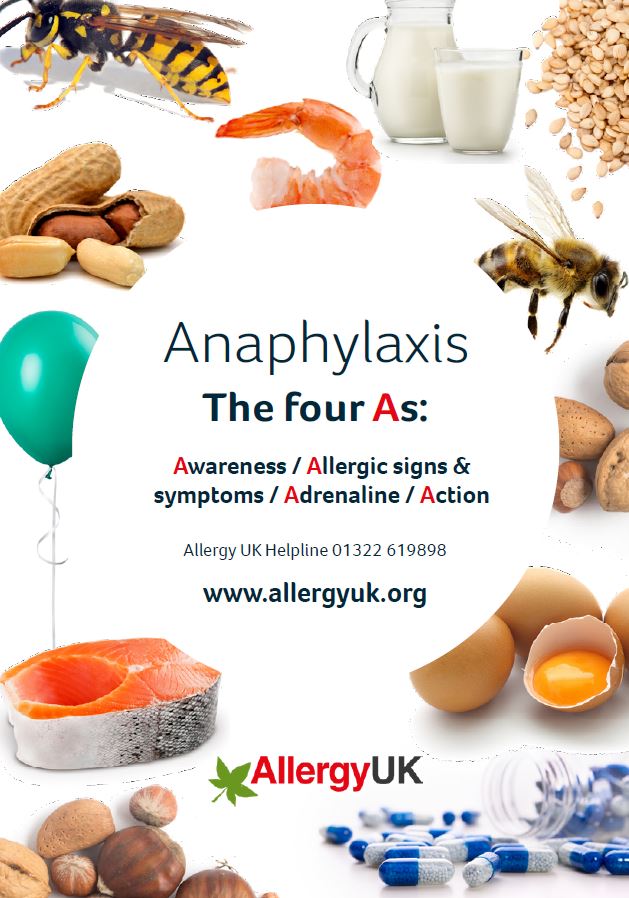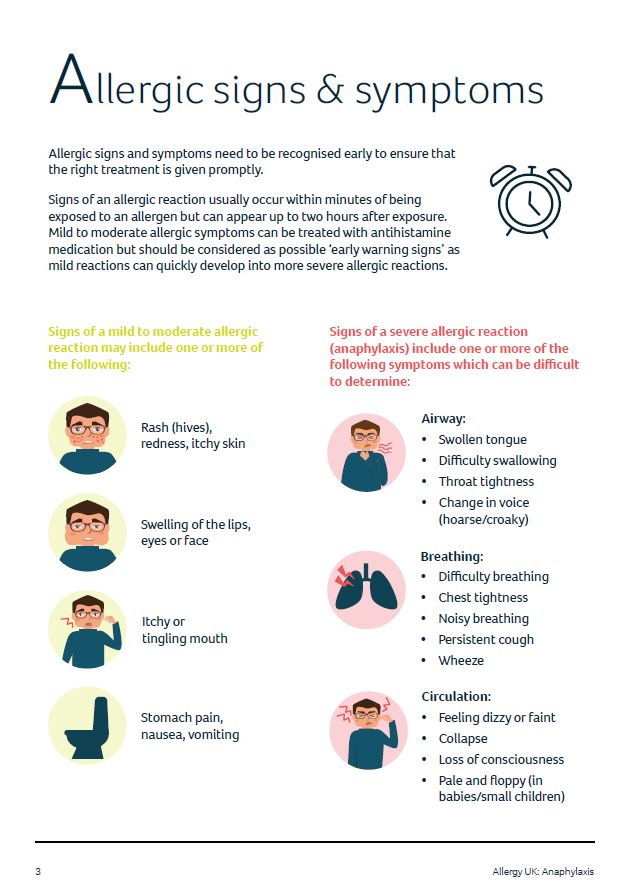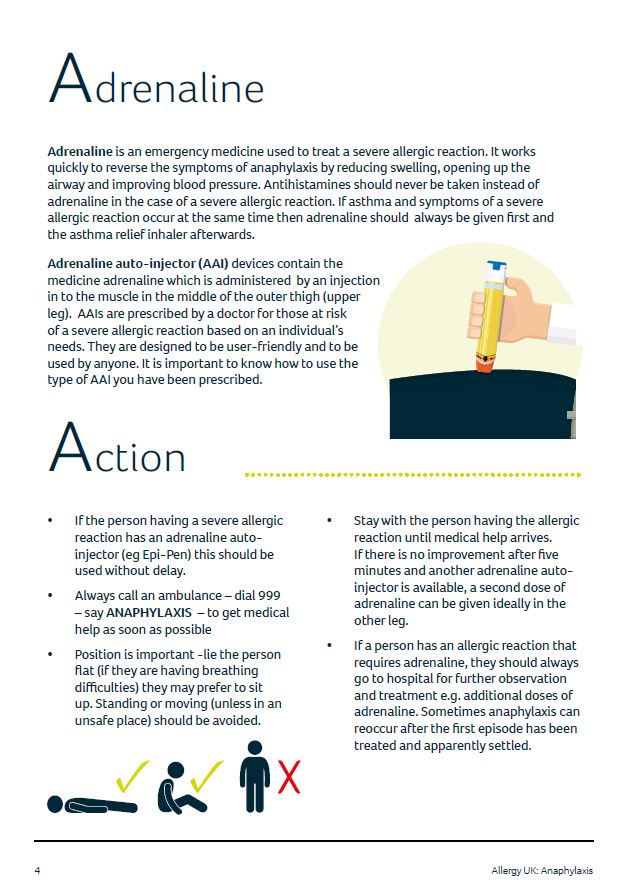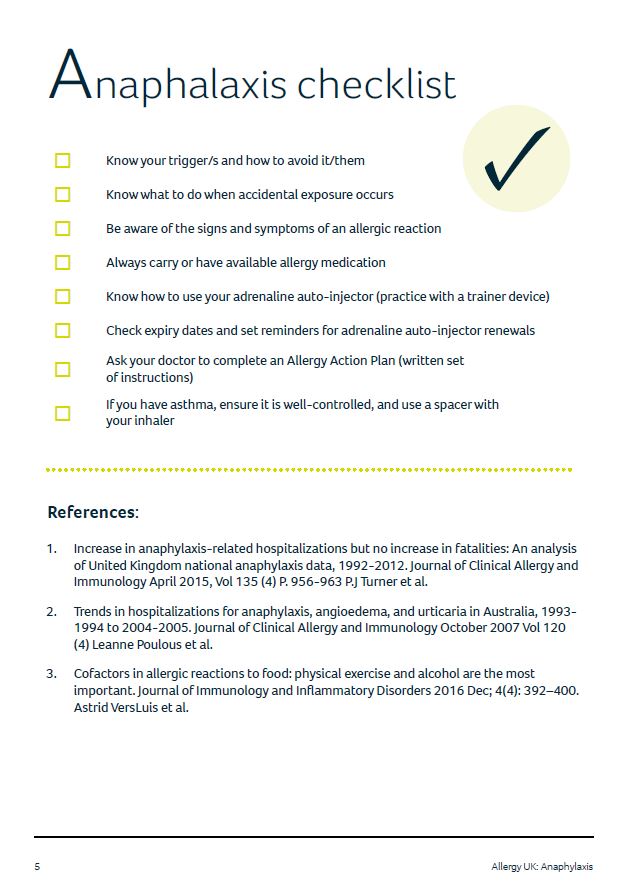Understanding anaphylaxis
Anaphylaxis is a severe and potentially life-threatening allergic reaction. It usually comes on within minutes of being exposed to the ‘allergen’ (the substance responsible for the allergic reaction) but it may take longer for symptoms to develop.
Anaphylaxis is a medical emergency. Recognising the signs and symptoms early and treating quickly with the medicine ‘adrenaline’ is vital. Anaphylaxis can be triggered by foods,
medications, insect venom (insect stings) or other substances, for example latex. The most common cause of anaphylaxis in children is food, whilst medication and insect venom are more common triggers in adults. Sometimes there is no known cause for an anaphylactic reaction. This is called idiopathic anaphylaxis.
Common allergic triggers include:
- Food (cow’s milk, egg, fish, peanut, sesame and tree nuts)
- Medications (antibiotics such as penicillin, pain medication such as aspirin or drugs used for operations for sedation and anesthesia)
- Venom (from stinging insects like bees and wasps)
- Latex (rubber gloves, balloons, condoms)
Allergic reactions can be mild, moderate or severe, with the most severe and life-threatening type called anaphylaxis. Anaphylaxis affects many important systems in the body including the airway, breathing and circulation.
There is no way of predicting how mild, moderate or severe an allergic reaction
will be.
Risk factors for anaphylaxis include asthma that is not well-controlled and/or having had a previous severe allergic reaction.
Other factors that may affect how severe an allergic reaction is include:
- Physical exercise
- Medication – prescription and recreational drug use
- Alcohol
- Stress
- Infection/high temperature
- Hormones
Allergic signs & symptoms
Allergic signs and symptoms need to be recognised early to ensure that the right treatment is given promptly.
Signs of an allergic reaction usually occur within minutes of being exposed to an allergen but can appear up to two hours after exposure. Mild to moderate allergic symptoms can be treated with antihistamine medication but should be considered as possible ‘early warning signs’ as mild reactions can quickly develop into more severe allergic reactions.
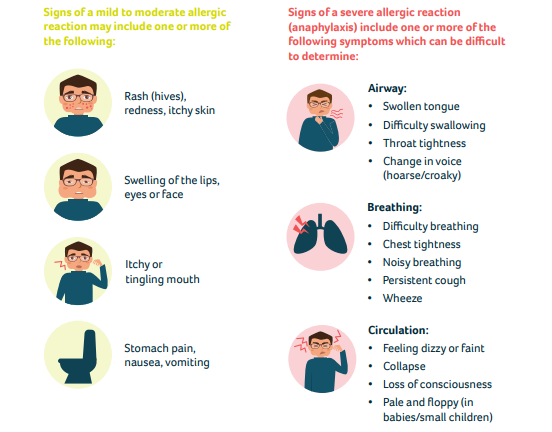
Adrenaline
Adrenaline is an emergency medicine used to treat a severe allergic reaction. It works quickly to reverse the symptoms of anaphylaxis by reducing swelling, opening up the airway and improving blood pressure. Antihistamines should never be taken instead of adrenaline in the case of a severe allergic reaction. If asthma and symptoms of a severe allergic reaction occur at the same time then adrenaline should always be given first and the asthma relief inhaler afterwards.
Adrenaline auto-injector (AAI) devices contain the medicine adrenaline which is administered by an injection in to the muscle in the middle of the outer thigh (upper leg). AAIs are prescribed by a doctor for those at risk of a severe allergic reaction based on an individual’s needs. They are designed to be user-friendly and to be used by anyone. It is important to know how to use the type of AAI you have been prescribed.
Action
- If the person having a severe allergic reaction has an adrenaline autoinjector (eg Epi-Pen) this should be used without delay.
- Always call an ambulance – dial 999 – say (ANA-FIL-AXIS) – to get medical help as soon as possible
- Position is important – lie the person flat. If they feel that their breathing is affected by this position, as in asthma, then help them sit up slightly but do not stand them up. Standing or moving (unless in an unsafe place) should be avoided.
- Stay with the person having the allergic reaction until medical help arrives. If there is no improvement after five minutes and another adrenaline autoinjector is available, a second dose of adrenaline can be given ideally in the other leg.
- If a person has an allergic reaction that requires adrenaline, they should always go to hospital for further observation and treatment e.g. additional doses of adrenaline. Sometimes anaphylaxis can reoccur after the first episode has been treated and apparently settled.
Anaphalaxis checklist
- Know your trigger/s and how to avoid it/them
- Know what to do when accidental exposure occurs
- Be aware of the signs and symptoms of an allergic reaction
- Always carry or have available allergy medication
- Know how to use your adrenaline auto-injector (practice with a trainer device)
- Check expiry dates and set reminders for adrenaline auto-injector renewals
- Ask your doctor to complete an Allergy Action Plan (written set of instructions)
- If you have asthma, ensure it is well-controlled, and use a spacer with your inhaler
- Always have two adrenaline auto-injectors immediately available

 Helpline
Helpline